
MARS FOREST LIFE BIO-DIVERSITY-09
Report #118
April 22, 2007
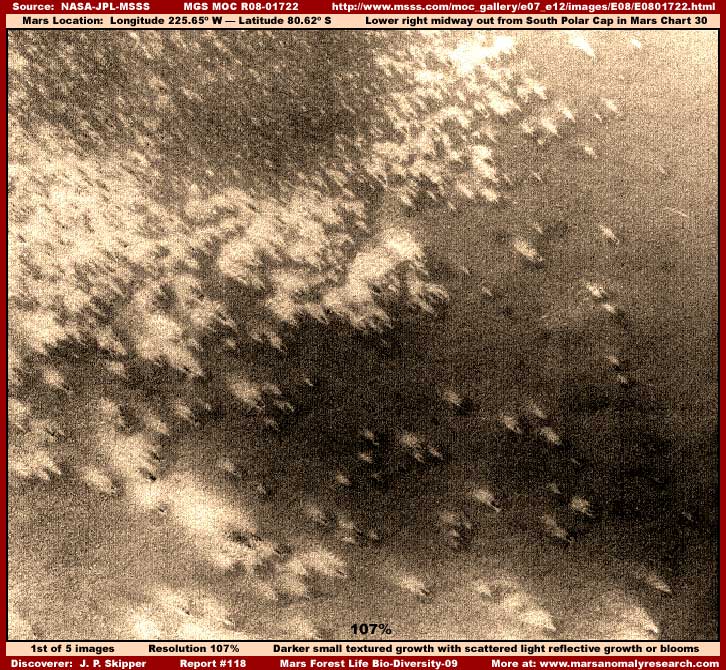
The above first image evidence is not something that I would normally report on simply because I doubt that very many would be able to distinguish this from geological terrain. This type of evidence is common in the Mars distant obfuscated satellite imaging. I pass over reporting on evidence like this often because I suspect many would see this as just too inconclusive. Yet it is biological life and it is included in this report because it is present in this strip and it demonstrates yet another example of a different looking Mars forest life bio-diversity.
This section of evidence comes from the mid-upper area of the original strip. Nothing that you are looking at in this larger than my normal size image is geological rock and soil terrain but rather a forest of flourishing densely packed life. More specifically the darker material is some kind of finer smaller textured and pattern biological life engulfing this terrain area. Unfortunately, the massed individual objects in the darker material are too small and the resolution too poor to allow determining any more about it than that.
Then there is the larger more course light reflective evidence you see above. It may be a different life form erupting out of this biological sea of life via spout or plume activity on top of the finer texture evidence to establish its own presence like a collection of individual islands in this area. On the other hand, it may simply be the same darker fine textured life but seen as a permanent spout/plume/bloom function making a transition to another stage of development. We just don't know and, as is often the case, the visual evidence often raises more questions than it answers.
Remember though that this is not Earth but another world with its own unique evolutionary paths. As you will come to know in this evidence record, some of those paths are very unique and unknown to us. Often they take the form of spouts/plumes or blooms that may be temporary or even semi-permanent to permanent in nature establishing different looking structures. In any case, so much for that, let's move on now in the following images to the principle evidence and reason for this report.
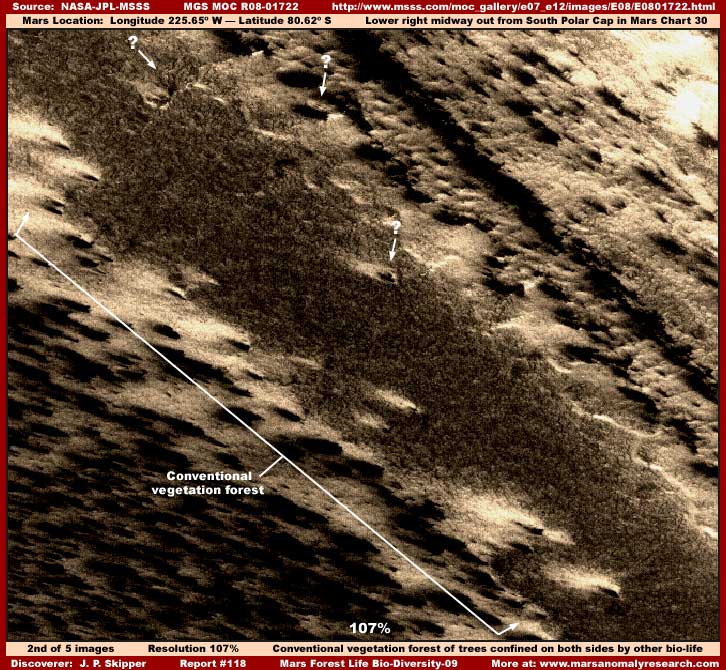
Now we come to the above second image and the main reason for this reporting from just this one image strip. This evidence comes from lower down near the bottom in the original strip from an terrain area made up of parallel bands of material. Such bands are often seen in the South Polar Region where this particular evidence comes from. The view of these bands is most often distant with too poor resolution. That in turn leads scientists to the "assumption" that the strange bands are always geological rock and soil terrain material effected into these bands in some unknown way.
Of course, they never consider that this effect may be function of life. Why not? Because the instrument science data tells them that the Mars atmosphere is made up primarily of 95+% Carbon Dioxide (CO2) many times over lethal to larger life forms as we know them to exist here on Earth. Also because the same data tells them that the planet is super dry and hard frozen. They appear to accept this without question and this basic fundamental data in turn goes into their computer models that of course in turn returns results that reinforce these geological conclusions. Garbage in and garbage out.
However, once it begins to dawn on the viewers of this evidence record that Mars terrain is too often mistakenly identified as geology when it is actually super dense vast areas of polyps/algae/mold growth, that "data" and what constitutes and forms these bands obviously needs to be reconsidered by open minds. Unless I've missed my guess, I suspect these bands of biological life are dictated by mild but long term effect atmospheric pressure and magnetic bands in combination with ground nutrient and moisture conditions.
Also, when it comes to biological life evidence in this distant satellite obfuscated poor imaging, the method of taking photos of the planet surface, at least as publicly presented to us, is itself a problem. The narrow-angle closer imaging takes a swath out of the evidence that is too narrow relative to the vast area of bio-life evidence coverage of the terrain. These evidence areas are old growth that may have existed in these terrain areas not just for centuries but for thousands of years, if not longer, and their coverage of vast areas is complete, solid, and densely packed.
This means that the growth fills the narrow-angle image view from edge to edge without break (like taking a too close picture of a too large section of carpet of continuous repeat sameness) and so the image swath rarely reveals the edges of the evidence fields where the growth may be struggling in poorer conditions and/or competing with other different growth thereby revealing variations in the growth in order to reveal that it is in fact living growth. Likewise, the more distant wide-angle imaging giving a much larger regional area view is characterized by too much distance and poor resolution that just will not reveal enough detail on such evidence unless it is colossal in size individual objects like the 12-mile across head monument I have reported on.
So it is very rare to find an image strip that will reveal an entire bio-life evidence field and from an identifiable distance and from boundary edge to boundary edge. It is even rarer to find one of conventional tree evidence we might be familiar with the visuals of here on Earth and be able to more readily recognize because the automated tampering programming also does a better job of recognizing this and eliminating it. Yet, that is what is happening with the above second image taken from one side edge of the original strip to the other.
What we have here in the above larger second image view is a lengthy but relatively narrow band of conventional woody tree forest mini-ecosystem evidence squeezed, trapped, bounded, and isolated within the greater parallel terrain bands configuration that the automated obfuscation tactics have failed to recognize and eliminate. It is bounded on the upper right by larger band of what appears to be algae biological growth evidence and on the lower left by a larger band of different unknown biological life evidence characterized by many large dark spot areas. If this relatively isolated conventional tree forest were here on Earth, it would be termed a forest "fragment" as a result of its smaller size and isolation factor.
Note that I have also pointed out some suspicious looking anomalous objects with white arrows. The one on the lower right is a slightly elevated unidentified object in a clearing in the trees. The clearing in this otherwise heavy growth suggest artificial maintenance maintaining this space but isn't conclusive in this regard. The upper middle also slightly elevated object appears to be slightly pointed on both ends suggesting possibly a slightly pointed, elliptical or round craft of some kind but again isn't conclusive in this regard. The object on the upper left appears to be some sort of relatively tall strange looking unidentified dark object the lower part of which is hidden behind a wall or natural rock feature mostly hidden by the vegetation but which appears to be casting a dark shadow to its left on the ground in a cleared area of the vegetation behind the obscuring wall feature.
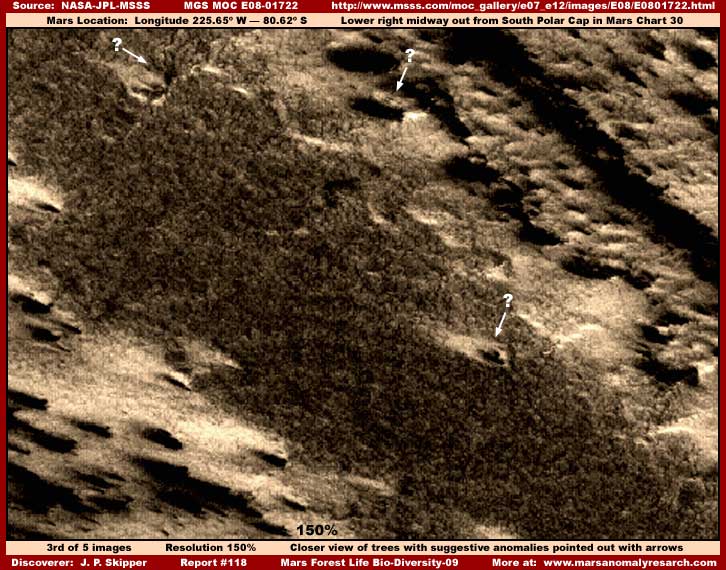
The above third image with its 150% zoom factor is included to make sure that a significant amount of the vegetation tree evidence can be seen at its best as compared to the second image above and the fourth image below with its 200% closer but also more blurry view. Note that all three anomalous objects are included in this slightly closer view but the resolution and detail just isn't quite good enough for this material to get beyond being merely suggestive and crossing over into real solid evidence.
Now when I identify this as conventional tree forest evidence, I am referring to the visual recognizability factor of it being in general individual object hard or soft wood tree vegetation life of some kind comparable to what we are visually familiar with here on Earth and not colony life such as polyps, algae or mold that are also so prevalent on Mars. This is very important. Why? Because vegetation that we are familiar with here on Earth has definite limits as to how much cold it can stand. Too much cold disrupts its cellular structure resulting in death. That means that conventional vegetation we might be familiar with here on Earth cannot exist in the extreme cold the science instrument data says is present at times on Mars and specifically in the South Polar Region right where this evidence is located.
Therefore, if the above visual evidence strongly suggests conventional tree forest vegetation on Mars and that evidence is not struggling but dense and flourishing, this has all kinds of implications for the correctness and accuracy of the Mars science instrument temperature data. Obviously the temperature clearly isn't that cold. Same but to a lesser extent with the science instrument Carbon Dioxide data. To give you a good idea of just what a dense old growth tree forest canopy looks like with boundary edges, visit my Report #100 and specifically Part-1 with its Earth tree forest canopy fragment evidence for direct comparison with the tree forest evidence you see here on Mars.
Yes tree forest can function in stronger Carbon Dioxide conditions but also remember that when this happens the resulting extensive tree forests, assuming they function similar to that on Earth, also pump a lot of Oxygen back into the atmosphere. In fact, remember that the presence of conventional tree forests (as shown elsewhere in this website's evidence record) flourishing and doing well and on a vast scale on Mars would clearly reinforce this concept and logically suggests the presence of a balance between Carbon Dioxide and Oxygen in the atmosphere likely favorable to life as we know it here on Earth. That consideration in turn logically has all sorts of implications for the correctness and accuracy of the official science instrument data that Mars has primarily a 95+% Carbon Dioxide atmosphere.
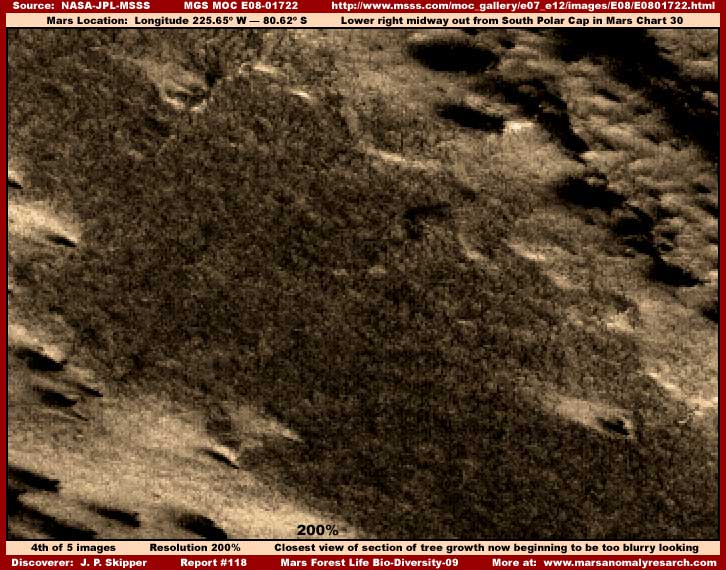
The above fourth image is a 200% zoom factor closer view of a section of the Mars vegetation forest evidence. I have not imaged the bands of algae growth evidence or other growth on either side of this band of tree evidence because the main thrust of this report is the conventional vegetation woody forest tree evidence. This view is just beginning to get a little too blurry but it is still informative as to being able to identify this as mostly conventional woody tree forest fragment evidence.
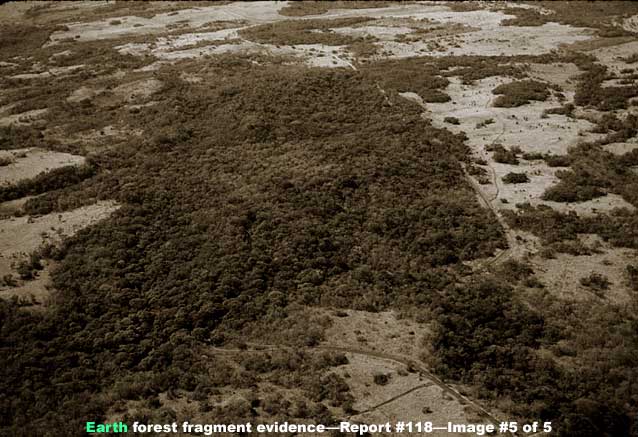
Courtesy:
University of Pennsylvania, Department of Biology, D. H. Janzen, Professor
http://fusion.sas.upenn.edu/caterpillar/viewimage.cfm?id=784&lecture=26&slide=23
Now in the above fifth image I want you to compare the Mars vegetation forest fragment evidence in the previous 2–4 images to this similar looking Earth based hardwood forest fragment evidence. This Earth evidence comes as a more oblique closer aerial view without obfuscation tactics and resolution problems present in it and so the view of detail making up the forest canopy upper surface is of course better than in the much greater distant and resolution compromised Mars satellite imaging lacking in such subtle detail.
Further, the non-forest areas in the Earth image represented by the smoother more light reflective surfaces are more open grasslands as compared to the Mars vegetation forest fragment being hemmed to a narrow band by smoother surfaced more light reflective colony growth less familiar to and recognizable by the Earth human eye. I've taken the original color out of the Earth image and introduced new color to better match the Mars evidence for better comparison but have made no other changes in it.
If you want to see the original Earth forest fragment in its original color, just click on the above link under the Earth image to access it. However, just be prepared to see the scene there through a bluish tint filter that tends to cause a slight haze effect that tends to diminish fine detail slightly. Otherwise, you will be able to verify there that I've done nothing else to the Earth evidence other than the color change.
Most of the time in the MGS MOC Mars satellite narrow-angle imaging, conventional tree forest fragment evidence and especially tree evidence on a scale reasonably large enough to be identifiable complete with identifiable boundary edges, is too heavily obscured. But, once in a rare while something escapes the obfuscation and a little truth peaks through. We are fortunate that this is what has happened here with this narrow strip of Mars tree forest evidence confined into a narrow band bracketed by other larger bands of mostly colony life evidence that is harder to differentiate from natural geological terrain. This is no doubt what confused the automated tampering software into it not recognizing this forest fragment evidence as a candidate for its heavier administrations.
Again, never forget that this terrain area is right in an South Polar Region area mid way out from the Cap right where it is suppose to be so hard freezing cold at times according to the official science data and all the implications that come with that. It is in a broad regional area characterized primarily by lower and level terrain with many different forms of strange looking colony biological life flourishing rather than woody tree forests, even in fragments. It probably continues to survive as a forest fragment in this otherwise isolated band location because it is in slightly elevated dryer ground conditions that are a little more favorable to its growth in this limited spot and not quite as favorable to colony life growth that probably requires more ground moisture content.
The primary reason I'm showing you this Mars conventional woody tree forest type evidence is to demonstrate once again that such more easily identified evidence does exist in absolute terms on Mars compared to the stranger and also prevalent Mars biological life evidence. This includes in locations that limit its growth and spread as exampled here as compared to other South Polar Region areas that are more elevated and more favorable to and result in vast massive old growth woody tree regional forests rather than colony life presence.
Clearly, if the temperature in this South Polar Region area ever fell even remotely anywhere near the –180 F. to –220 F. freezing cold extremes as indicated by the official statistics during any one relatively recent season, this evidence that takes so many years to grow to this stage of maturity simply could not exist. That it does exist at all and in this mature form is very telling evidence of the true Mars environmental conditions.
So the visual evidence speaks for itself but are any scientists or academics really paying any attention? Are any of these so well educated people out there questioning their basic assumptions and belief systems yet? Is it beginning to dawn on you that you've trusted where you shouldn't have? You biologists and botanists out there, you know what you are obviously looking at here on Mars right off the end of your nose on your computer screen. Get some courage and step up!
Remember, science is suppose to be all about questioning not just the evidence presented here but that which you have historically been fed bits and pieces over the years, decades and generations by sources you've trusted too much. Historically well accepted consensus information does not make the information true, it only indicates a psychological state of mind in a population that tends to dictate behavior. At one point in the Earth past, the educated consensus opinion of the time that held sway for so many centuries was that the Earth was flat and that of course was far from the truth. Yet, it continued to hold on for generations after the undermining obvious truth was revealed. Is that they way it is going to be when it comes to space exploration? Surely we've come further than that.
Questionable National Security considerations have been taking advantage of you and your well educated and thoroughly entrenched and conditioned naiveté for decades and you might as well begin to wake up to it and deal with it. Beginning to do so now is better than later! Remember, once the hammer drops and the tide turns driven by these growing and you can count on them being relentless evidence revelations, the window of opportunity for saving face will have sailed on by never to return.
DOCUMENTATION
http://www.msss.com/moc_gallery/e07_e12/images/E08/E0801722.html: This link takes you to the official E08-01722 narrow-angle strip that is the sole source of the evidence presented here in Report #118. The evidence is drawn from the fourth listed slower loading but higher detail straight .GIF strip without any form of manipulation of the strip. The tree evidence is just above the bottom of the strip where sections of multiple bands are to be found. The tree evidence is nestled within those bands.
, Investigator
![]()